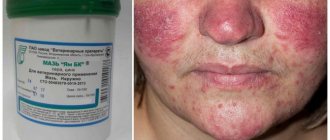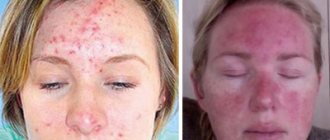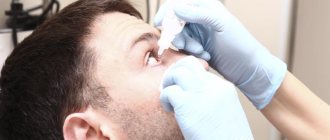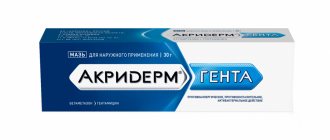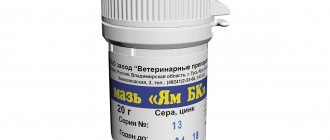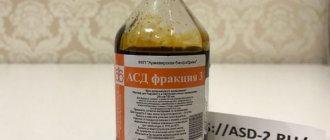Demodectic mange is one of the most unpleasant eye diseases. It is caused by opportunistic parasites, mites of the genus Demodex. In every second person, they live in small numbers on the skin of the face, eyelash follicles and in the sebaceous glands of the eyelid, but when favorable conditions occur, the mites begin to multiply rapidly and cause a disease such as ophthalmodedecosis , causing irritation and discomfort in the eyes.
1
Diagnosis and treatment of demodicosis
2 Diagnosis and treatment of demodicosis
3 Treatment of demodicosis
How it develops
Scientists have confirmed that the likelihood of the disease is not affected by a person’s age or gender. Most often, demodicosis develops on the face and head, since the cervix in these areas contains many sebaceous glands, the secretions of which serve as food for the mite.
Order an antiparasitic drug directly from the manufacturer
Pathology occurs due to:
- low immunity;
- impaired sebum production;
- the presence of skin diseases.
Often the person himself is to blame for infection with demodicosis. Self-removal of pimples, acne, ulcers and other formations helps the mite penetrate deep into the CP. Demodectic mange can also be a consequence of long-term use of antibiotics and steroid hormones, or the use of low-quality decorative cosmetics.
Bad habits and poor nutritional diet also contribute to the development of demodicosis.
Close contact with an infected person also leads to demodicosis. But this is only possible if the patient has more than 30 parasites in one sebaceous gland.
Order an antiparasitic drug directly from the manufacturer
Important! Demodicosis also develops in pets. But its pathogens are completely safe for humans.
Demodicosis
Symptoms of the disease
Often, signs of demodicosis appear on the head, nose, nasolabial triangle, forehead, cheeks, chin and eyelids, since it is in these places that sebum is produced in large quantities. Its amount increases if the patient’s body has disrupted hormonal levels, the functionality of internal organs or immunity.
Many dermatologists agree that the main symptom of demodicosis is the appearance of rosacea (rosacea) on the skin. A person may suffer from persistent skin hyperemia, pink papules, and pustules. The advanced stage of the disease is manifested by compaction of the KP and spider veins. The patient begins to complain of severe itching and a feeling of tightening of the joint. Lack of adequate therapy leads to the development of rhinophyma. The intensity of the manifestation of symptoms is enhanced by an oily KP and enlarged pores.
In elderly people, in addition to the above symptoms, ocular demodicosis develops, manifested by blepharoconjunctivitis and blepharitis. They suffer from dry eyes, foreign body sensation, redness, and watery eyes. Gradually, the eyelids begin to itch, swell, and turn red. Eyelashes become thin and brittle and quickly fall out. In the morning, the edges of the eyelids are covered with sticky discharge, crusts and scales.
Order an antiparasitic drug directly from the manufacturer
Indications for the use of ointments and gels for demodicosis of the eyelids
Ointments for demodicosis should be used at the first symptoms of this disease, namely the following signs:
- swelling of the edges of the eyelids;
- eye fatigue against the background of developing inflammatory infectious processes;
- loss of eyelashes that lose their strength;
- redness of the eyelids.
Such inflammatory reactions can be noticed already in the first days of the development of the disease.
And if inflammation affects only the eyelids and practically does not spread to the conjunctival membrane, it is necessary to use ointments and gels for demodicosis.
How does it work?
Metronidazole is a drug with an antibiotic effect. It effectively copes with various bacterial diseases. Today the drug exists in the form of a gel, tablets and solution. The first two dosage forms are more suitable for home use. One of the main advantages of Metronidazole is its active impact on the causes of demodicosis. The active ingredients penetrate bacterial elements and quickly destroy them. Also, after using the drug, there are no scars left on the joint, which is very important.
The medication has a broad spectrum of action, so it is often used in dermatology. Low price, good effect and the possibility of use for the treatment of many skin diseases make Metronidazole a unique drug.
Analogs
| Name | Active substance | Maximum therapeutic effect, hours | Price per package, rub. |
| Metrogil | metronidazole | 2 | 23-185 |
| Rozamet | metronidazole | 3 | 191-210 |
| Metroseptol | metronidazole | 2 | 160 |
| Efloran | metronidazole | 2-3 | 801 |
Substitutes are used in cases where the patient is allergic to the components that make up Trichopolum. In any case, therapy is prescribed by the attending physician.
In what cases is it prescribed
In addition to demodicosis, the drug is prescribed against:
Order an antiparasitic drug directly from the manufacturer
- impaired functionality of the gastrointestinal tract;
- hormonal disorders, especially in adolescents;
- dermatosis, especially chronic.
Also, the drug and drugs created on its basis effectively cope with:
- amoebic organ damage;
- giardiasis of the duodenum;
- abscesses affecting bones and soft tissues;
- skin infections;
- inflammation of the periosteum and bone structures;
- colitis;
- infectious infections after surgery.
For people who need treatment for demodicosis, it is better to take Metronidazole orally (tablets) or use it externally (Metrogil gel). A qualified specialist should decide which dosage form is most suitable. At the same time, he takes into account the degree of damage and the individual characteristics of the patient.
Trichopolum ointment
Since we are talking about skin lesions, treatment of demodicosis is not possible without topical application. The optimal solution would be Trichopolum ointment. It easily copes with ticks and their larvae. To ensure the effectiveness of the course, you must take the medicine as prescribed by your doctor. It is important to take into account a number of factors.
Do not forget that treatment is carried out not only locally, but also with drugs for internal use. This is the only way to solve the problem in a fairly short time.
Instructions for use
Metronidazole should be used only as prescribed by a doctor. He will study the degree of development of demodicosis and develop a treatment regimen. The patient must only comply with all instructions. Let's look at the features of using gels and tablets.
Order an antiparasitic drug directly from the manufacturer
Features of gel treatment
Metrogyl is sold without a prescription in every pharmacy. It is transparent and odorless. To achieve a good effect, the substance must be used to treat areas of the CP affected by demodicosis, previously cleaned of dust and dirt. The doctor decides how many times a day this procedure should be performed. The treatment course takes 21-30 days. Its duration can be adjusted. The gel is easy to use and does not cause discomfort.
How to take the pills
Separately or as an addition to external use, the doctor may prescribe tableted Metronidazole. As a rule, you need to take 250 mg tablets in the morning and evening for 7-10 days. This treatment is prescribed to patients in whom demodicosis has led to the development of serious internal inflammation. But often the tablets can be used to prepare emulsions, masks and lotions for topical use.
Recipe 1
To create an effective homemade lotion, grind 5 tablets into powder, add 100 ml of water, mix well. Soak a cotton pad in the prepared mixture and apply it to the affected skin. Carry out the procedure twice a day.
Order an antiparasitic drug directly from the manufacturer
Recipe 2
Mix crushed tablets and white clay in equal quantities, add water to make the mixture slightly thick, stir. Wash, pat your face with a dry towel and apply the mask to the affected areas for 15 minutes. Then rinse off.
The duration of such treatment should only be determined by a doctor. Using Metronidazole in any form as self-medication can negatively affect your health.
The doctor must decide how to use the medicine against demodicosis
Acne complicated by demodicosis. Part 2
Acne complicated by demodicosis. Part 2
Author: Doctor of Medical Sciences, Professor of the Department of Skin and Venereal Diseases of the Institute of Postgraduate Education of the First Moscow State Medical University named after. I. M. Sechenova V. I. Albanova. The contents of the first part of the article can be found here.
VERA ALBANOVA
Professor of the Department of Skin and Venereal Diseases of the MMA named after. I.M. Sechenova (Moscow) Treatment prescribed on 03/04/14:
■ orally: special dragee “Merz” (Merz, Germany) 1 pill 2 times a day after meals for up to 2 months; ■ externally: – gel “Baziron AS” (contains benzoyl peroxide 5%; Laboratoires Galderma, France) – to suppress the growth of propionibacteria, only on pustules and areas of inflammation in the morning; – retinoic ointment 0.05% (contains isotretinoin 0.05%; FSPP “Retinoids”, Russia) - to normalize sebum secretion and keratinization, on the entire face (except for the area around the eyes and corners of the mouth) at night; ■ the following Christina products (Israel) have been added to home care: – Unstress Stabilizing tonic, contains extracts of cucumber, arnica, panthenol, glycolic and lactic acid) – for wiping the skin in the morning, refreshes the skin, tightens pores, relieves inflammation; – Unstress Replenishing Mask (contains B vitamins, wheat germ oil, St. John’s wort and plumeria leaf extracts, panthenol, hyaluronic acid) – in the evening every other day, soothes and nourishes the skin.
The treatment lasted for one and a half months. During this time, comedones, papules and pustules became isolated, faint spots and scars were noticeable at the sites of resolved rashes, the skin remained dry in places, but there was no peeling.
Treatment prescribed on April 29, 2014:
■ orally: dietary supplement "Omegatrin" (contains omega 3-6-9 fatty acids; Newman Nutrients, Switzerland) - to strengthen the barrier structures of the stratum corneum and reduce inflammatory manifestations, 1 capsule 2-3 times a day for 2 months;
■ externally: – local masking corrector when new rashes appear (no more than a day); – gel “Baziron AS” (Laboratoires GALDERMA, France) - only on pustules and areas of inflammation in the morning; – retinoic ointment 0.05% (FNPP “Retinoids”, Russia) - on the area of rashes daily, on the entire face (except for the area around the eyes and corners of the mouth) in the evening every other day; ■ it is recommended to add professional care to home care. The goal of professional care is to eliminate post-acne phenomena (scars and spots on the cheeks) and provide more intense hydration. Cosmetological procedure (07/19/14) and recommendations
of a cosmetologist The patient contacted a cosmetologist (already her third) two and a half months later. The first cosmetic procedure he performed was as follows: skin cleansing, ultrasonic cleansing, pigment tightening mask, brightening mask, serum with a-hydroxy acids and hyaluronic acid. The cosmetologist recommended excluding seafood and salt from the diet.
The cosmetologist suggested making changes to the treatment: ■ orally: retinol palmitate 8 drops 1 time per day with meals for a month;
■ externally: instead of retinoic ointment 0.05% every other day, cream with adapalene is prescribed daily, as well as gel with metronidazole for 2 weeks every 3 months; ■ cosmetic procedures: – plasma lifting – in September; – yellow peeling Retises CT-Yellow peel (sachet – retinol 4%, retinyl propionate 1%; ampoule solution – ascorobyl glucoside 10%, niacinamide 5%, pH 5.0; Mediderma/SesDerma, Spain) – in October; – Comodex Alpha Beta Peel peeling (contains glycolic, lactic, salicylic acids, green tea and tomato extracts, pH 2.5; Christina, Israel) - every 2-3 weeks; ■ enhancing home care with porcelain masks Christina (Israel) based on kaolin: – Porcelan Mask Astringent mask (contains kaolin, camphor, triclosan, eucalyptus leaf oil) – to tighten pores; – Porcelan Mask Moisture mask (contains kaolin, marine collagen, hyaluronic acid, amino acid complex, urea, thyme extract) – to moisturize the skin. Discussion
Often the first specialist whom patients with acne turn to is a cosmetologist. This is what happened in this case.
Despite the obvious diagnosis and active inflammation, the first cosmetologist resorted not to drug treatment, but to cosmetic mechanical cleansing and peeling, and seeing an insufficient clinical effect, he increased the intensity of the peeling, which resulted in a skin burn. In the summer, mites of the genus Demodex multiplied in damaged skin with increased sebum secretion, which gave symptoms of deterioration of the skin condition and itching.
The second cosmetologist did not conduct any tests for demodex, but judging by the prescribed treatment, the idea of demodicosis still occurred to him. Metronidazole and calendula tincture, which have acaricidal properties, were prescribed, but the treatment was short-term and insufficient to eradicate mites. To reduce itching, the antiallergic drug Cetrin was prescribed (according to the patient, the cause of the itching was assumed to be an allergic reaction to cosmetics). Itching with demodicosis does not require the use of antihistamines; it is eliminated by eradication of the pathogen. Therefore, it is understandable why the antihistamine was ineffective. Judging by the many prescribed cosmetic procedures, the main hope was placed on them, although injection mesotherapy and biorevitalization, associated with skin trauma, is not only doubtful, but unacceptable against the background of active inflammation. Carrying out hygienic cleaning 2 times a week in this case, in our opinion, is too frequent; cleaning 1 time a week would have been enough. As for laser therapy, it does not have a pigment-constricting effect, but it soothes inflamed skin. However, against the background of constant trauma to the skin with injection procedures and frequent cleansing, the anti-inflammatory effect was not as pronounced as would be desirable.
After laboratory confirmation of the presence of demodicosis, external treatment was prescribed with an ointment similar in composition to the well-known recipe for “Yam” ointment (Unguentum Yam). This treatment turned out to be quite effective, and after eradication of the mites, external anti-acne agents were prescribed - benzoyl peroxide (Baziron AS gel) and isotretinoin (retinoic ointment 0.05%). Benzoyl peroxide has a bactericidal effect, isotretinoin reduces sebum production and eliminates hyperkeratosis. Both products, when used for a long time, weaken the barrier properties of the skin and cause dryness, so additional protection of the skin from water loss and sun exposure is necessary. For this purpose, it is necessary to regularly use special cosmetics. After a significant improvement in the skin condition, the patient is gradually transferred to maintenance therapy - benzoyl peroxide is applied only to isolated inflammatory elements, and retinoic ointment 0.05% is used less and less (optimally during the period of remission, 2 times a week).
The recommendations of the third cosmetologist significantly change the treatment, and some seem very controversial, for example, restricting the diet of seafood and salt. Retinol palmitate at the prescribed dose (25,000 IU/day) does not have any effect on the sebaceous glands and keratinization, does not exhibit anti-acne activity, but simultaneously requires serious double contraception. The drug is prescribed for severe forms of acne at a dose of 300,000 IU/day once a day at night (see instructions for medical use). In a state of incomplete remission, there is no need to prescribe retinol palmitate. It is also not advisable to change isotretinoin to adapalene externally, since isotretinoin ointment is well tolerated and quite effective. The instructions and clinical recommendations do not provide for short courses of therapy with metronidazole gel as an anti-acne treatment. The effectiveness of plasma lifting in the treatment of acne has not been proven, and it is hardly advisable to carry it out at the age of 23 for the purpose of lifting. There are no objections to the use of light peelings.
At all stages of the disease, regular manual facial cleansing to remove comedones is desirable. The most important element of prevention and therapy is proper cleansing of the skin using special soap-free products with a pH of about 5.5. The use of products containing organic solvents (alcohol, acetone) is contraindicated, since they destroy the hydrolipid film and further weaken the skin barrier.
A good auxiliary means for the rapid restoration of the barrier are polyunsaturated fatty acids - omega-3/omega-6 (internally and externally). In case of severe inflammation, medications with retinoids (retinoic acids or adapalene) are prescribed. However, in the remission stage and to correct post-acne, they switch to cosmetic preparations with retinol and its esters. They can be used as a course or regularly in low concentrations.
It should be noted that the patient informed the dermatologist about the appointments of the third cosmetologist, and the further management scheme was agreed upon by two
specialists. The patient remains under observation by a dermatologist, and at the last visit, which was 08/23/14, further improvement in her condition was recorded
skin - absence of comedones, single papules, post-acne in the form of enlarged pores and slight pigmentation (photo 2 from 08/23/14). As a result, morning treatment was canceled and only retinoic ointment 0.05% 2 times a week and cosmetics were left.
Conclusion
Thus, it is advisable to use cosmetics and methods at all stages of treatment. Therefore, contact between two specialists to exchange experiences and develop a common strategy is necessary.
At the beginning of treatment, the leading role belongs to the dermatologist, who prescribes examination, drug therapy and mandatory cosmetological support. As you improve, more and more importance is attached to cosmetic procedures and cosmetic care.
And it depends on the cosmetologist how well the treatment result will be consolidated.
Webinar
Return to news list
Contraindications, restrictions
Despite its high effectiveness, Metronidazole is prohibited for use when:
Order an antiparasitic drug directly from the manufacturer
- pregnancy and lactation;
- acute renal and liver failure;
- hypersensitivity to the constituent components;
- impaired functionality of the central nervous system;
- chronic blood diseases.
Also, the medication is prohibited for use in the treatment of children and adolescents.
Why do you need to treat demodicosis?
Ignoring this disease will greatly aggravate the person’s condition and provoke the development of the following diseases.
Rosacea
The disease manifests itself as pustules, papules, rashes and skin inflammation. The face turns burgundy-red, the chest tightens, begins to itch and burn. Lack of adequate therapy will lead to thickening of the wings of the nose and an increase in its size. The disease can spread to the chest and back. The risk group includes fair-skinned women 30-50 years old.
Rosacea
Acne
It appears as flesh-colored nodules located in several groups on the face. May be accompanied by papules and pustules. A complex form of acne provokes the development of atrophic scars, bluish nodules and painful cysts. Acne most often appears on the cheeks, temples, upper back and chest. Black dots appear on the joint, it becomes lumpy, gradually becomes coarser and fatter.
Acne
Perioral dermatitis
It affects the nasolabial triangle, corners of the mouth, chin, head, and skin around the lips. It manifests itself as burgundy papules, persistent redness and pustules. If left untreated, it enters an acute stage, which provokes the development of:
- painful nodular neoplasms;
- large pustules;
- bluish rashes;
- itching;
- peeling;
- dryness;
- skin tightening.
Gradually, the KP becomes thin, opens the vascular network, and becomes covered with acne, pimples and rashes.
Seborrheic dermatitis
This disease manifests itself as pustules and papules that appear on the face, head, eyelids and eyebrows. Having become chronic, it affects:
- chest;
- armpits;
- groin;
- skin behind the ears.
A mild form of the disease can be confused with dandruff.
If left untreated, large scaly growths will affect the entire head. The KP under the crusts is red and inflamed. Since the skin is dry, bleeding microcracks appear on it, which constantly itch. The likelihood of contracting an infectious disease increases several times.
Demodicosis is a serious disease that requires qualified treatment. If you notice signs in yourself, do not rush to buy Metronidazole, but make an appointment with a dermatologist.
Causes of demodicosis of the eyes
This disease can appear as a result of internal factors:
- decreased immunity after illness;
- chronic microbial and viral diseases;
- the appearance of foci of infection in the body, for example, untreated caries;
- eye refractive diseases;
- hormonal disorders;
- seborrheic dermatitis;
- acne;
- disturbances in the functioning of the nervous and cardiovascular systems;
- diseases of the liver and gastrointestinal tract.
External factors can also trigger the appearance of demodicosis of the eyes:
- previous ophthalmic surgeries;
- dirty, dusty air;
- high air temperature;
- unhealthy lifestyle, alcohol abuse.
Untreated demodicosis can lead to keratitis, blepharoconjunctivitis, blepharitis and visual impairment. A deficiency of tear fluid is dangerous for the development of secondary infection.
